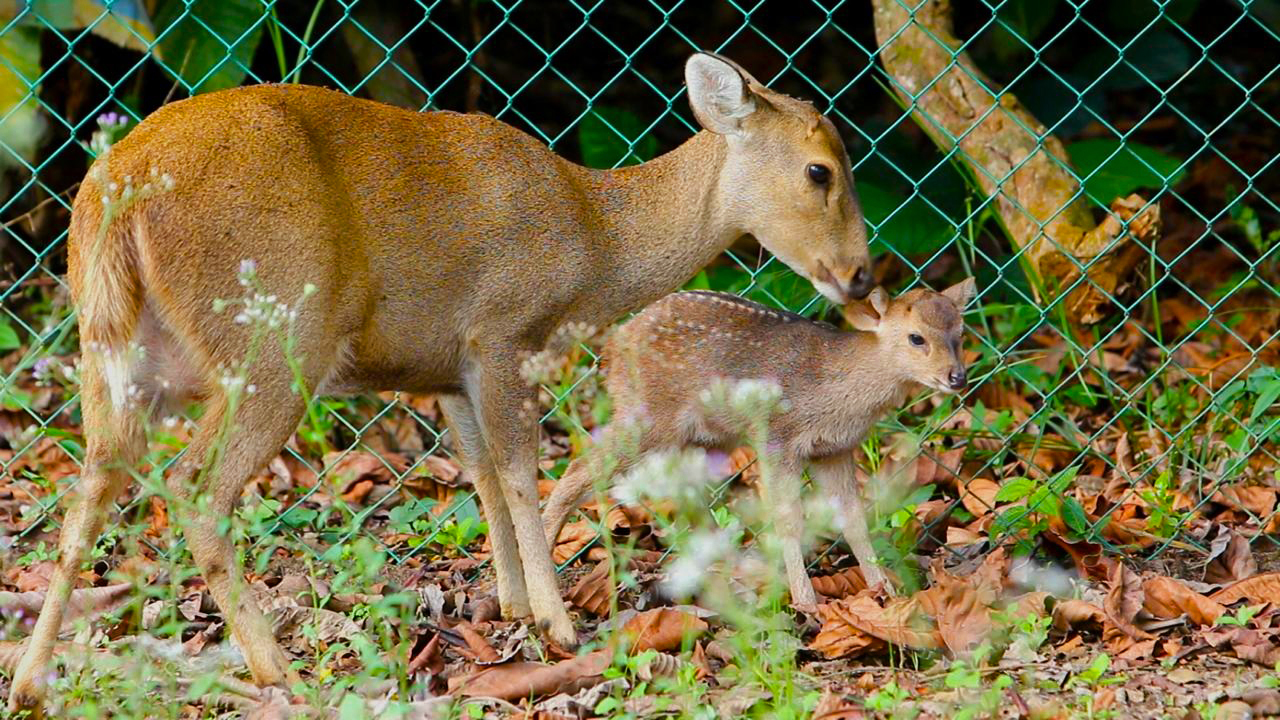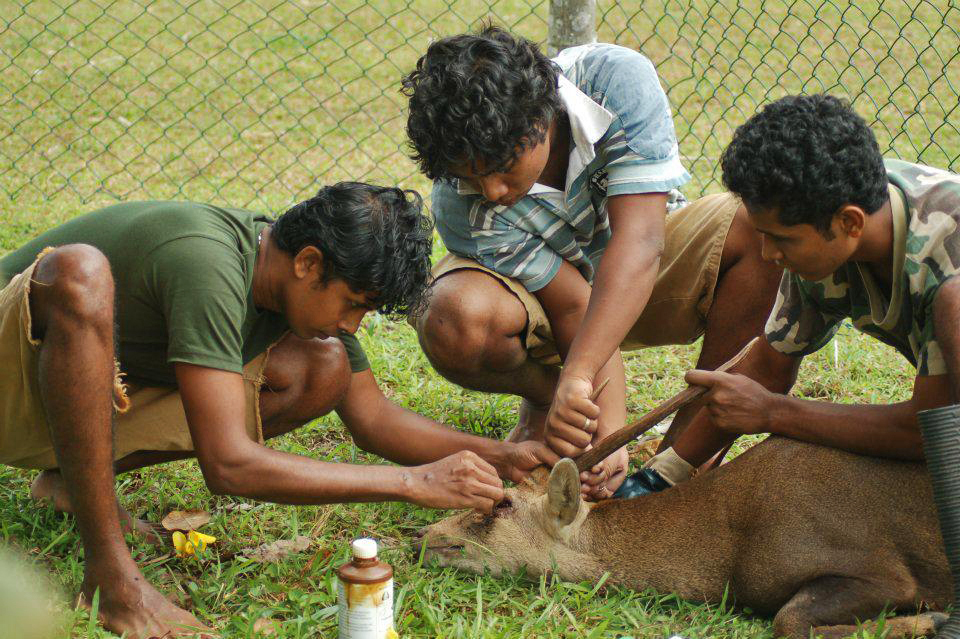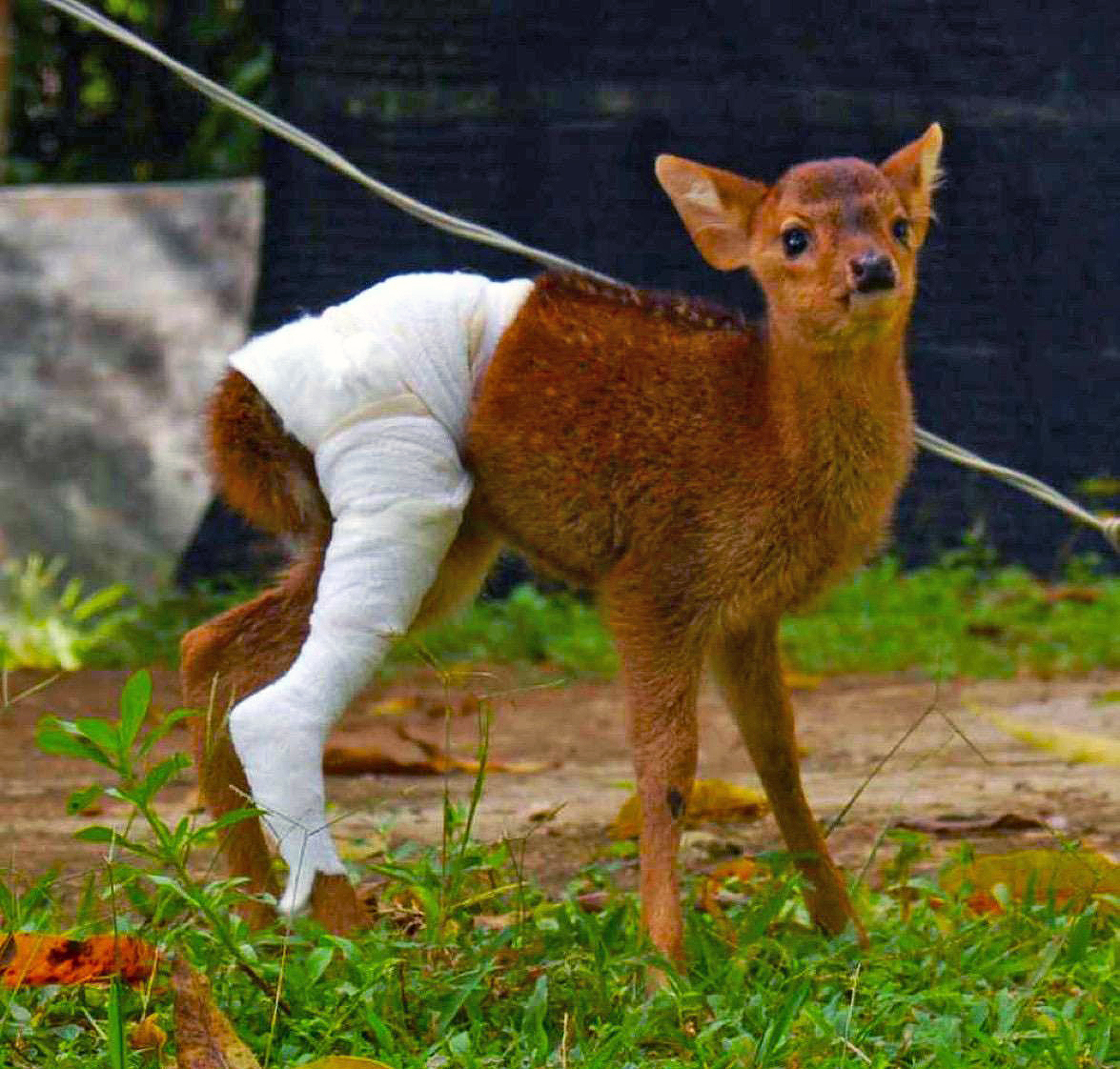- The hog deer (Axis porcinus), Sri Lanka’s most threatened deer species, is classified as critically endangered in the country and survives only in fragmented habitats in the island’s southwest.
- A year-long survey recorded 306 adults and 22 fawns, showing a modest increase in their numbers, but an array of threats continues to put pressure on the species’ survival.
- Conservationists warn against major threats including attacks by feral dogs and water monitors, road accidents and habitat loss, while garbage dumping alters predator dynamics, adding a fresh threat.
- Debate continues over whether Sri Lanka’s hog deer is native or introduced, with fossil evidence hinting at an ancient presence but some theories indicating colonial-era introductions.
GALLE, Sri Lanka — The hog deer is Sri Lanka’s rarest and most elusive deer, and was thought to be extinct a few decades ago. Classified as critically endangered within the nation, it now survives only in fragmented patches along the island’s southwestern coastal belt, making it a species of urgent conservation concern.
Unlike the more visible spotted deer (Axis axis ceylonensis), sambar (Rusa unicolor unicolor) and barking deer (Cervus muntjak), the hog deer (Axis porcinus) prefers marshy scrub forests adjoining wetlands. But with these habitats vanishing, the animal has adapted to human-modified landscapes, finding refuge in cinnamon plantations, rice fields and vegetable orchards. Today, most sightings come from the southern district of Galle, particularly between the Bentota and Gin rivers.
“The hog deer now rotates between rice and cinnamon fields. During the breeding season, females give birth in paddy fields, trampling a patch of rice to create a small area for the fawn. At other times, they retreat into cinnamon estates, feeding on new shoots,” says Kithsiri Ranawana, an emeritus professor in the zoology department in the University of Peradeniya.

A recent study by Ranawana and his postgraduate student Shashi Madhushanka confirmed 175 hog deer locations across Galle, documenting 306 adults and 22 fawns through a year-long questionnaire survey between December 2021 and December 2022. This marks an increase compared to earlier reports from the 1990s and 2010s.
However, challenges remain. The study highlighted crop damage — mainly to cinnamon, rice and vegetables — as a source of human-wildlife conflict. Farmers often view the deer as a pest.
Predators and human activities pose constant dangers. “Feral dogs and water monitors are major threats to fawns, while adults frequently fall victim to road accidents,” says Madura de Silva, president of the Wildlife Conservation Society of Galle (WCSG).
At the Hiyare Wildlife Rescue Centre in Galle, managed by WCSG, about 30-40 hog deer are treated annually, mostly from dog attacks and vehicle collisions. According to WCSG data, 40% of the hog deer sent to their rescue center are victims of dog attacks. Garbage dumping in wetlands increases the problem. “Food waste is fueling water monitor [Varanus salvator] populations, which in turn increases predation on hog deer,” de Silva tells Mongabay, adding that deer bitten by monitors are often difficult to save because the wounds quickly turn septic.

To secure the species’ future, WCSG launched a captive-breeding program in 2013 together with the Geoffrey Bawa Trust on Honduwa Island, which is located within hog deer range. Although hog deer are not naturally found on Honduwa, it has proven to be an ideal site for the program, De Silva says.
Since 2013, the initiative has successfully released a total of 76 individuals back into the wild. This also marks the first captive breeding program in Sri Lanka for an endangered animal, de Silva says.
These efforts have shown promise, with camera-trap studies capturing natural behavior patterns: crepuscular feeding, female groupings and a February-April fawning season. “It is the only critically endangered large mammal in Sri Lanka,” de Silva says. “Community engagement and habitat protection are essential for its survival.”

Native or outsider?
The hog deer gets its name from the way they move through the forest, running with their heads down like a hog or domestic pig, and how, unlike most deer species that leap over obstacles, they try to run under them.
The hog deer’s origins in Sri Lanka remain debatable. Some theories suggest colonial introduction by the Portuguese or Dutch as live food or hunting stock. Others point to ancient links with South and Southeast Asia.
Yet, fossil evidence — such as a lower jaw fragment dating back nearly 14,000 years — suggests a long-standing presence. Naturalist Asoka Yapa, author of the zoological book Land Mammals of Sri Lanka, dismisses the introduction theory. “Sri Lanka already had abundant game. The most logical conclusion is that hog deer have been here since at least the mid-Pleistocene,” he explains.

Globally, hog deer range from Pakistan to Vietnam, with introduced populations thriving in Australia, Texas and South Africa. But unlike in Australia, where they are considered invasive, Sri Lanka’s population is fragmented and restricted to about 220 square kilometers (85 square miles) in the southwest, with no populations in key protected areas.
Compared to Sri Lanka’s other deer species — the spotted deer, sambar and barking deer — the hog deer stands apart for its secretive, nocturnal nature and its marshland dependency. Its low-slung, hog-like gait makes it even harder to spot it in the wild, de Silva says.
Conservationists warn that, without stronger measures on feral dog control, wetland protection and DNA studies to clarify its taxonomic status, the species could slip away. “This is a unique part of Sri Lanka’s natural heritage,” says Ranil Nanayakkara of the Biodiversity Education and Research (BEAR). “Protecting it requires science-based management, community participation, and good environmental governance.”
Banner image: Free-roaming hog deer (Axis porcinus) found on Honduwa Island in southern Sri Lanka, where a captive breeding program has resulted in the successful release of 76 individuals into the wild. Image courtesy of the Wildlife Conservation Society of Galle (WCSG).
Mysterious sloth bear deaths raise alarm at Sri Lanka’s largest national park
Citations:
Madhushanka, S., & Ranawana, K.B. (2025). Conservation status, crop damage and distribution of the Hog Deer (Axis porcinus Zimmermann, 1780) in Galle District, Sri Lanka. University of Colombo Review (New Series III), 6(1). doi:10.4038/ucr.v6i1.181
Vishvanath, N., Nanayakara, R.P., & Herath, H.M.J.C.B. (2014). Current status, distribution and conservation of the Sri Lankan Hog Deer Hyelaphus porcinus (Zimmermann, 1780) (Cetartiodactyla: Cervidae). Journal of Threatened Taxa, 6(12): 6515–6522. doi:10.11609/JoTT.o3263.6515-22
